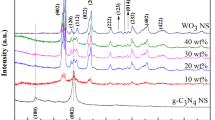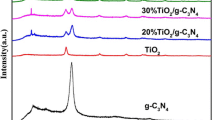Abstract
A set of four composite materials was prepared, consisting of a nanosponge matrix based on β-cyclodextrin in which carbon nitride was dispersed. The materials were characterized by the presence of diverse cross-linker units joining the cyclodextrin moieties, in order to vary the absorption/release abilities of the matrix. The composites were characterized and used as photocatalysts in aqueous medium under UV, visible and natural solar irradiation for the photodegradation of 4-nitrophenol, and for the selective partial oxidation of 5-hydroxymethylfurfural and veratryl alcohol to the corresponding aldehydes. The nanosponge-C3N4 composites showed higher activity than the pristine semiconductor, which can probably be attributed to the synergic effect of the nanosponge, capable of increasing the substrate concentration near the surface of the photocatalyst.
Graphical Abstract





Similar content being viewed by others
Bibliography
Swaminathan, S., & Trotta, F. (2019). Cyclodextrin Nanosponges. In F. Trotta, A. Mele (Eds.) Nanosponges: Synthesis and Applications (pp. 27–57). Wiley‐VCH Verlag GmbH & Co. KGaA. https://doi.org/10.1002/9783527341009.ch2.
Caldera, F., Tannous, M., Cavalli, R., Zanetti, M., & Trotta, F. (2017). Evolution of cyclodextrin nanosponges. International Journal of Pharmaceutics, 531, 470–479. https://doi.org/10.1016/j.ijpharm.2017.06.072
Lo Meo, P., Lazzara, G., Liotta, L., Riela, S., & Noto, R. (2014). Cyclodextrin–calixarene co-polymers as a new class of nanosponges. Polymer Chemistry, 5, 4499–4510. https://doi.org/10.1039/C4PY00325J
Spinella, A., Russo, M., Di Vincenzo, A., Chillura Martino, D., & Lo Meo, P. (2018). Hyper-reticulated calixarene polymers: a new example of entirely synthetic nanosponge materials. Beilstein Journal of Organic Chemistry, 14, 1498–1507. https://doi.org/10.3762/bjoc.14.127
Szejtli, J. (1998). Introduction and general overview of cyclodextrin chemistry. Chemical Reviews, 98, 1743–1754. https://doi.org/10.1021/cr970022c
Del Valle, E. M. M. (2004). Cyclodextrins and their uses: a review. Process Biochemistry, 39, 1033–1046. https://doi.org/10.1016/S0032-9592(03)00258-9
Matsui, Y., & Mochida, K. (1979). Binding forces contributing to the association of cyclodextrin with alcohol in an aqueous solution. Bulletin of the Chemical Society of Japan, 52, 2808–2814. https://doi.org/10.1246/bcsj.52.2808
Rekharsky, M. V., & Inoue, Y. (1998). Complexation thermodynamics of cyclodextrins. Chemical Reviews, 98, 1875–1918. https://doi.org/10.1021/cr970015o
Liu, L., & Guo, Q.-X. (2002). The driving forces in the inclusion complexation of cyclodextrins. Journal of inclusion phenomena and macrocyclic chemistry, 42, 1–14. https://doi.org/10.1023/a:1014520830813
Lo Meo, P., D’Anna, F., Gruttadauria, M., Riela, S., & Noto, R. (2004). Thermodynamics of binding between α- and β-cyclodextrins and some p-nitro-aniline derivatives: reconsidering the enthalpy–entropy compensation effect. Tetrahedron, 60, 9099–9111. https://doi.org/10.1016/j.tet.2004.07.079
Lo Meo, P., D’Anna, F., Riela, S., Gruttadauria, M., & Noto, R. (2009). Binding equilibria between β-cyclodextrin and p-nitro-aniline derivatives: The first systematic study in mixed water-methanol solvent systems. Tetrahedron, 65, 2037–2042. https://doi.org/10.1016/j.tet.2009.01.008
Danil de Namor, A. F., Cleverley, R. M., & Zapata-Ormachea, M. L. (1998). Thermodynamics of calixarene chemistry. Chemical Reviews, 98, 2495–2526. https://doi.org/10.1021/cr970095w
Mutihac, L., Buschmann, H. J., Mutihac, R. C., & Schollmeyer, E. (2005). Complexation and separation of amines, amino acids, and peptides by functionalized calix[n]arenes. Journal of Inclusion Phenomena, 51, 1–10. https://doi.org/10.1007/s10847-004-5098-x
Sliwa, W., & Deska, M. (2008). Calixarene complexes with soft metal ions. ARKIVOC, 2008, 87–127. https://doi.org/10.3998/ark.5550190.0009.104
Khan, A. R., Forgó, P., Stine, K. J., & D’Souza, V. T. (1998). Methods for selective modifications of cyclodextrins. Chemical Reviews, 98, 1977–1996. https://doi.org/10.1021/cr970012b
Van Loon, J. D., Arduini, A., Coppi, L., Verboom, W., Pochini, A., Ungaro, R., Harkema, S., & Reinhoudt, D. N. (1990). Selective functionalization of calix[4]arenes at the upper RIM. The Journal of Organic Chemistry, 55, 5639–5646. https://doi.org/10.1021/jo00308a024
Cataldo, S., Lo Meo, P., Conte, P., Di Vincenzo, A., Milea, D., & Pettignano, A. (2021). Evaluation of adsorption ability of cyclodextrin-calixarene nanosponges towards Pb2+ ion in aqueous solution. Carbohydrate Polymers, 267, 118151. https://doi.org/10.1016/j.carbpol.2021.118151
Mamba, B. B., Krause, R. W., Malefetse, T. J., Gericke, G., & Sithole, S. P. (2009). Cyclodextrin nanosponges in the removal of organic matter for ultrapure water in power generation. Journal of Water Supply: Research and Technology - Aqua, 58, 299–304. https://doi.org/10.2166/aqua.2009.039
Allahyari, S., Trotta, F., Valizadeh, H., Jelvehgari, M., & Zakeri-Milani, P. (2019). Cyclodextrin-based nanosponges as promising carriers for active agents. Expert Opinion on Drug Delivery, 16, 467–479. https://doi.org/10.1080/17425247.2019.1591365
Fontana, R. M., Milano, N., Barbara, L., Di Vincenzo, A., Gallo, G., & Lo Meo, P. (2019). Cyclodextrin-calixarene nanosponges as potential platforms for pH-dependent delivery of tetracycline. ChemistrySelect, 4, 9743–9747. https://doi.org/10.1002/slct.201902373
Trotta, F., Dianzani, C., Caldera, F., Mognetti, B., & Cavalli, R. (2014). The application of nanosponges to cancer drug delivery. Expert Opinion on Drug Delivery, 11, 931–941. https://doi.org/10.1517/17425247.2014.911729
Di Vincenzo, A., Russo, M., Cataldo, S., Milea, D., Pettignano, A., & Lo Meo, P. (2019). Effect of pH variations on the properties of cyclodextrin-calixarene nanosponges. ChemistrySelect, 4, 6155–6161. https://doi.org/10.1002/slct.201901200
Russo, M., Saladino, M. L., Chillura Martino, D., Lo Meo, P., & Noto, R. (2016). Polyaminocyclodextrin nanosponges: synthesis, characterization and pH-responsive sequestration abilities. RSC Advances, 6, 49941–49953. https://doi.org/10.1039/c6ra06417e
Trotta, F., Caldera, F., Dianzani, C., Argenziano, M., Barrera, G., & Cavalli, R. (2016). Glutathione bioresponsive cyclodextrin nanosponges. ChemPlusChem, 81, 439–443. https://doi.org/10.1002/cplu.201500531
Li, H., Meng, B., Chai, S.-H., Liu, H., & Dai, S. (2016). Hyper-crosslinked β-cyclodextrin porous polymer: an adsorption-facilitated molecular catalyst support for transformation of water-soluble aromatic molecules. Chemical Science, 7, 905–909. https://doi.org/10.1039/C5SC04034E
Martin-Trasanco, R., Cao, R., Esparza-Ponce, H. E., Montero-Cabrera, M. E., & Arratia-Pérez, R. (2017). Reduction of Au(III) by a β-cyclodextrin polymer in acid medium. A stated unattainable reaction. Carbohydrate Polymers, 175, 530–537. https://doi.org/10.1016/j.carbpol.2017.08.013
Noel, S., Bourbiaux, D., Tabary, N., Ponchel, A., Martel, B., Monflier, E., & Leger, B. (2017). Acid-tolerant cyclodextrin-based ruthenium nanoparticles for the hydrogenation of unsaturated compounds in water. Catalysis Science & Technology, 7, 5982–5992. https://doi.org/10.1039/C7CY01687E
Russo, M., Spinella, A., Di Vincenzo, A., Lazzara, G., Correro, M. R., Shahgaldian, P., Lo Meo, P., & Caponetti, E. (2019). Synergistic activity of silver nanoparticles and polyaminocyclodextrins in nanosponge architectures. ChemistrySelect, 4, 873–879. https://doi.org/10.1002/slct.201803424
Wang, X., Maeda, K., Thomas, A., Takanabe, K., Xin, G., Carlsson, J. M., Domen, K., & Antonietti, M. (2009). A metal-free polymeric photocatalyst for hydrogen production from water under visible light. Nature Materials, 8, 76–80. https://doi.org/10.1038/nmat2317
Marcì, G., García-López, E. I., & Palmisano, L. (2018). Polymeric carbon nitride (C3N4) as heterogeneous photocatalyst for selective oxidation of alcohols to aldehydes. Catalysis Today, 315, 126–137. https://doi.org/10.1016/j.cattod.2018.03.038
Krivtsov, I., García-López, E. I., Marcì, G., Palmisano, L., Amghouz, Z., García, J. R., Ordóñez, S., & Díaz, E. (2017). Selective photocatalytic oxidation of 5-hydroxymethyl-2-furfural to 2,5-furandicarboxyaldehyde in aqueous suspension of g-C3N4. Applied Catalysis B: Environmental, 204, 430–439. https://doi.org/10.1016/j.apcatb.2016.11.049
Ilkaeva, M., Krivtsov, I., García, J. R., Díaz, E., Ordóñez, S., García-López, E. I., Marcì, G., Palmisano, L., Maldonado, M. I., & Malato, S. (2018). Selective photocatalytic oxidation of 5-hydroxymethyl-2-furfural in aqueous suspension of polymeric carbon nitride and its adduct with H2O2 in a solar pilot plant. Catalysis Today, 315, 138–148. https://doi.org/10.1016/j.cattod.2018.03.013
Krivtsov, I., Ilkaeva, M., García López, E. I., Marcì, G., Palmisano, L., Bartashevich, E., Grigoreva, E., Matveeva, K., Díaz Fernández, E., & Ordóñez García, S. (2019). Effect of substituents on partial photocatalytic oxidation of aromatic alcohols assisted by polymeric C3N4. ChemCatChem, 11, 2713–2724. https://doi.org/10.1002/cctc.201900362
Ilkaeva, M., Krivtsov, I., García-López, E., Marcì, G., Khainakova, O., García, J., Palmisano, L., Díaz, E., & Ordóñez, S. (2018). Selective photocatalytic oxidation of 5-hydroxymethylfurfural to 2, 5-furandicarboxaldehyde by polymeric carbon nitride-hydrogen peroxide adduct. Journal of Catalysis, 359, 212–222. https://doi.org/10.1016/j.jcat.2018.01.012
Garcia-Lopez, E. I., Abbasi, Z., Di Franco, F., Santamaria, M., Marcì, G., & Palmisano, L. (2021). Selective oxidation of aromatic alcohols in the presence of C3N4 photocatalysts derived from the polycondensation of melamine, cyanuric and barbituric acids. Research on Chemical Intermediates, 47, 131–156. https://doi.org/10.1007/s11164-020-04330-5
Augugliaro, V., Palmisano, L., Schiavello, M., & Sclafani, A. (1986). Photodecomposition of adsorbed ethanoic acid over silica gel catalyst in a flow system. Journal of Catalysis, 99, 62–71. https://doi.org/10.1016/0021-9517(86)90198-3
Sclafani, A., Palmisano, L., Schiavello, M., Augugliaro, V., Coluccia, S., & Marchese, L. (1988). The photodecomposition of ethanoic acid adsorbed over semiconductor and insulator oxides. Part 1. pure oxides. New Journal of Chemistry, 12, 129–135.
Gondal, M. A., Chang, X., Ali, M. A., Yamani, Z. H., Zhou, Q., & Ji, G. (2011). Adsorption and degradation performance of Rhodamine B over BiOBr under monochromatic 532 nm pulsed laser exposure. Applied Catalysis, A: General, 397, 192–200. https://doi.org/10.1016/j.apcata.2011.02.033
Author information
Authors and Affiliations
Corresponding authors
Ethics declarations
Conflict of interest
On behalf of all authors, the corresponding author states that there is no conflict of interest.
Supplementary Information
Below is the link to the electronic supplementary material.
Rights and permissions
Springer Nature or its licensor (e.g. a society or other partner) holds exclusive rights to this article under a publishing agreement with the author(s) or other rightsholder(s); author self-archiving of the accepted manuscript version of this article is solely governed by the terms of such publishing agreement and applicable law.
About this article
Cite this article
García-López, E.I., Arcidiacono, F., Di Vincenzo, A. et al. Nanosponge-C3N4 composites as photocatalysts for selective partial alcohol oxidation in aqueous suspension. Photochem Photobiol Sci 22, 1517–1526 (2023). https://doi.org/10.1007/s43630-023-00394-5
Received:
Accepted:
Published:
Issue Date:
DOI: https://doi.org/10.1007/s43630-023-00394-5




